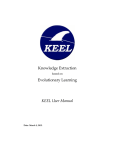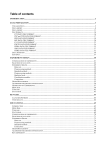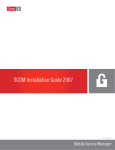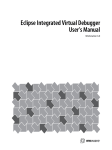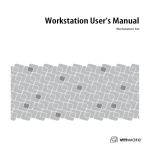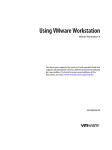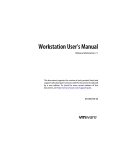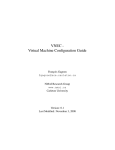Download Red Hat ENTERPRISE LINUX 4 - DEBUGGING WITH GDB Specifications
Transcript
Integrated Virtual Debugger for Eclipse Developer’s Guide VMware Workstation 8.0 This document supports the version of each product listed and supports all subsequent versions until the document is replaced by a new edition. To check for more recent editions of this document, see http://www.vmware.com/support/pubs. EN-000172-01 Integrated Virtual Debugger for Eclipse Developer’s Guide You can find the most up-to-date technical documentation on the VMware Web site at: http://www.vmware.com/support/ The VMware Web site also provides the latest product updates. If you have comments about this documentation, submit your feedback to: [email protected] Copyright © 1998-2011 VMware, Inc. All rights reserved. This product is protected by U.S. and international copyright and intellectual property laws. VMware products are covered by one or more patents listed at http://www.vmware.com/go/patents. VMware is a registered trademark or trademark of VMware, Inc. in the United States and/or other jurisdictions. All other marks and names mentioned herein may be trademarks of their respective companies. VMware, Inc. 3401 Hillview Ave. Palo Alto, CA 94304 www.vmware.com 2 VMware, Inc. Contents About This Book 5 1 Using the Integrated Virtual Debugger for Eclipse 7 Debugging Environment of the Integrated Virtual Debugger 7 Installation Requirements of the Integrated Virtual Debugger for Eclipse 8 Host System Requirements 8 Supported Host Operating Systems 8 Supported JRE Versions 9 Eclipse Requirements 9 Installing and Uninstalling the Integrated Virtual Debugger for Eclipse 9 VMware Tools Requirements 9 2 Remote Debugging in Java Environment 11 Virtual Machine Requirements for Debugging Java Applications 11 Supported Guest Operating Systems 11 Update the Eclipse Build Settings to Use a 1.4.x JRE 12 Installing PSAPI.DLL on Windows NT 12 Disabling the Firewall on Linux Guest Systems 12 Configure the Firewall on Windows Guest Systems 12 Managing Virtual Machine Launch Configurations 13 Use Application Configurations to Start Applications in a Virtual Machine 13 Use Configurations to Attach to Applications Running in a Virtual Machine 14 Delete a Configuration 14 Running and Debugging Applications in Virtual Machines 14 Start an Application Debugging Session in a Virtual Machine 15 Start an Application in a Virtual Machine Without Debugging 15 Attach to an Application Running in a Virtual Machine 15 3 Remote Debugging in the C and C++ Environment 17 Virtual Machine Requirements for C and C++ Applications 17 Supported Guest Operating Systems 17 Install Eclipse Classic 3.4.x on the Host 18 Use Proxy for Network Connection 18 Install C and C++ Development Toolkit and Remote System Explorer Plug‐ins 19 Install the Eclipse Plug‐in Manually 19 Disabling the Firewall on Guest Systems 19 Managing Virtual Machine Launch Configurations 20 Set Debug Configuration Settings to Start Applications in a Virtual Machine 20 Delete a Configuration 20 Running and Debugging Applications in Virtual Machines 21 Start an Application Debugging Session in a Virtual Machine 21 Start an Application in a Virtual Machine Without Debugging 21 Troubleshooting the C and C++ Environment 21 Debugging Session Fails to Start 21 Debugging Session Fails to Start and Protocol Error Appears 22 Eclipse Fails When You Start a Debugging Session 22 Reverting to the Recent Snapshot Stops Responding 22 Log in Authentication Error on the Guest 22 VMware, Inc. 3 Integrated Virtual Debugger for Eclipse Developer’s Guide Index 25 4 VMware, Inc. About This Book The Integrated Virtual Debugger for Eclipse Developer’s Guide provides information on how to install the Integrated Virtual Debugger for Eclipse. The guide also provides information on how to manage launch configurations to debug Java or C and C++ applications in multiple virtual machines simultaneously or multiple sessions in a single virtual machine. Intended Audience This book is intended for anyone who wants to debug in a virtual machine. The information in this book is written for experienced Windows or Linux developers and QA Engineers who are familiar with virtual machine technology and the debugging process. Document Feedback VMware welcomes your suggestions for improving our documentation. If you have comments, send your feedback to [email protected]. Technical Support and Education Resources The following sections describe the technical support resources available to you. To access the current version of this book and other books, go to http://www.vmware.com/support/pubs. Online and Telephone Support To use online support to submit technical support requests, view your product and contract information, and register your products, go to http://www.vmware.com/support. Customers with appropriate support contracts should use telephone support for the fastest response on priority 1 issues. Go to http://www.vmware.com/support/phone_support.html. Support Offerings To find out how VMware support offerings can help meet your business needs, go to http://www.vmware.com/support/services. VMware Professional Services VMware Education Services courses offer extensive hands‐on labs, case study examples, and course materials designed to be used as on‐the‐job reference tools. Courses are available onsite, in the classroom, and live online. For onsite pilot programs and implementation best practices, VMware Consulting Services provides offerings to help you assess, plan, build, and manage your virtual environment. To access information about education classes, certification programs, and consulting services, go to http://www.vmware.com/services. VMware, Inc. 5 Integrated Virtual Debugger for Eclipse Developer’s Guide 6 VMware, Inc. 1 Using the Integrated Virtual Debugger for Eclipse 1 The Integrated Virtual Debugger for Eclipse provides a configurable interface between Eclipse and virtual machines making it easy to develop and debug, on a single PC, applications that run on multiple operating systems. Debugging your applications in virtual machines enables you to reproduce and record errors while maintaining the integrity of the host machine. This chapter contains the following sections: “Debugging Environment of the Integrated Virtual Debugger” on page 7 “Installation Requirements of the Integrated Virtual Debugger for Eclipse” on page 8 “Installing and Uninstalling the Integrated Virtual Debugger for Eclipse” on page 9 Debugging Environment of the Integrated Virtual Debugger The Integrated Virtual Debugger lets you debug Java or C++ applications in a virtual machine. It is often necessary to debug an application in many different environments. With the Integrated Virtual Debugger you can debug a Java or C++ application on different operating systems and different JVMs. For example, you can also debug using different versions of Windows, service packs, DLLs installed, and so on. Using virtual machines for debugging provides a convenient alternative to debugging on physical machines because you can debug an application on different setups. The Integrated Virtual Debugger helps manage your virtual machines. The Integrated Virtual Debugger can power guest virtual machines on and off, start the application in its virtual machine, attach the debugger to the application, and control the application. The typical debugging tasks such as pausing at breakpoints, stepping through code, and viewing and modifying the state of your application, can be performed without impacting the host environment. The Integrated Virtual Debugger also enables you to: Manage launch configuration settings for application execution and debugging in virtual machines. Start an application debugging session in a virtual machine. Start an application in a virtual machine without debugging. Start a debugging session that attaches to a process already running in a virtual machine. Using Eclipse launch configurations, you can choose a virtual machine in which to run your application and determine how the application is executed. When configured, the Integrated Virtual Debugger finds the virtual machine, powers it on if necessary, sets up the environment based on your configuration settings, and starts or attaches to the application. To configure how an application is started in a virtual machine, you can specify: Name of the virtual machine (.vmx configuration file). Account credentials for guest console. (Optional) Path to the Java Virtual Machine (JVM) on the guest system. (Optional) Locations of folders to be shared between the host and the guest. VMware, Inc. 7 Integrated Virtual Debugger for Eclipse Developer’s Guide (Optional) Actions to take before launching an application from Eclipse, including: Revert to the most recent snapshot. Run specified pre‐execution commands. (Optional) Actions to take after an application launched from Eclipse is terminated, including: Run specified post‐execution commands (for example, to perform cleanup tasks). Set the virtual machine state to: Suspended (default) Revert to the most recent snapshot Powered off Installation Requirements of the Integrated Virtual Debugger for Eclipse The Integrated Virtual Debugger is supported for Workstation 7.0. Host System Requirements The Integrated Virtual Debugger for Eclipse can run on any supported host operating system that is running Workstation 7.0 and has Eclipse installed. Eclipse must be running on the same host system as Workstation 7.0. For information about Eclipse versions, see “Eclipse Requirements” on page 9. Supported Host Operating Systems The Integrated Virtual Debugger supports the following Windows 32‐bit, Windows 64‐bit, Linux 32‐bit, and Linux 64‐bit host operating systems. Table 1-1. Windows and Linux Host Operating Systems Operating System Edition Windows 32‐bit Windows 7 Ultimate Edition Windows 7 Enterprise Edition Windows 7 Professional Windows 7 Home Premium Windows 7 Home Basic Windows Vista Enterprise Edition, SP1 Windows Vista Business Edition, SP1 Windows Vista Home Basic and Premium Editions, SP1 Windows Vista Ultimate Edition, SP1, SP3 Listed versions are also supported with no service pack. Windows XP Home Edition with SP2 or later service pack Windows XP Professional with SP2 or later service pack Windows 64‐bit Windows 7 Ultimate Edition Windows 7 Enterprise Edition Windows 7 Professional Windows 7 Home Premium Windows 7 Home Basic Windows XP Professional with SP1 or later service pack Linux 32 and 64‐bit Red Hat Enterprise Linux WS 4.5 (Beta, formerly called 4.0 Update 5) Red Hat Enterprise Linux AS 4.0, updates 1, 2, 3, 4 Red Hat Enterprise Linux ES 4.0, updates 1, 2, 3, 4 Red Hat Enterprise Linux WS 4.0, updates 1, 2, 3, 4 Red Hat Linux 9.0 — stock 2.4.20‐8, upgrade 2.4.20‐20.9 Ubuntu Linux 8.04, 8.10, and 9.04 Other Linux distributions might work, but were not tested. 8 VMware, Inc. Chapter 1 Using the Integrated Virtual Debugger for Eclipse Supported JRE Versions The host system must be running a Java runtime environment (JRE) meeting Java 2 Platform Standard Edition (J2SE) 5.0 or higher specifications. J2SE consists of the JRE and developer tools for compiling, debugging, and running applications written in the Java language. NOTE Eclipse displays the error message unable to load class if an unsupported version of J2SE is being used on the host system. Eclipse Requirements For debugging Java applications, the Integrated Virtual Debugger supports Eclipse 3.2, 3.3, 3.3.x, 3.4, and 3.4.x. Eclipse 3.5 might work, but was not tested. On Windows Vista hosts, you must have Eclipse 3.2.2 or higher installed. Only the Java language is supported. NOTE You cannot have GNU Compiler for the Java programming language (GCJ) or GNU Interpreter for Java (GIJ) installed on either the host or guest operating system. To debug C and C++ applications with the Integrated Virtual Debugger, you must have Eclipse Classic 3.4.x and higher and Java 6 installed on the host. On Windows hosts, you must have MinGW with gdbserver 6.6 installed. The MinGW with gdbserver 6.6 download is available from the sourceforge.net Web site. Installing and Uninstalling the Integrated Virtual Debugger for Eclipse You must install the appropriate version of Eclipse on the host. For information about the required Eclipse versions to debug Java or C and C++ applications, see “Eclipse Requirements” on page 9. Before you begin installing Workstation, make sure that you have the prerequisites listed in “Installation Requirements of the Integrated Virtual Debugger for Eclipse” on page 8. When you install the latest version of Workstation with Eclipse present, the Workstation installer installs the Integrated Virtual Debugger for Eclipse. For information about how to install Workstation, see the Workstation User’s Manual on the VMware Web site. If you install Eclipse after you install Workstation, run the Workstation installer again and select the Modify option to install the Integrated Virtual Debugger for Eclipse. When you install the Integrated Virtual Debugger for Eclipse: For the JRE, the Integrated Virtual Debugger plug‐in, ivd.jar, Foundry Java bindings, and the plugin.xml launch configuration file are placed in the com.vmware.bfg_1.0.0 subdirectory of the Eclipse plug‐in directory. After you restart Eclipse, the Debug menu includes the new launch configuration types VMware attach to application and VMware execute Java application. These launch configuration types have a VMware tab that enables you to configure virtual machine settings. For C and C++ debugging, the Integrated Virtual Debugger plug‐in installs in the following directories: <Eclipse_Features_Directory>/com.vmware.remotedebug.ccpp.feature_1.0.0/ <Eclipse_Plugin_Directory>/com.vmware.remotedebug.ccpp_1.0.0.jar <Eclipse_Plugin_Directory>/com.vmware.vixapi_1.0.0.jar <Eclipse_Plugin_Directory>/com.vmware.vixservice.connectorservice_1.0.0.jar <Eclipse_Plugin_Directory>/com.vmware.vixservice.services_1.0.0.jar <Eclipse_Plugin_Directory>/com.vmware.vixservice.subsystems_1.0.0.jar <Eclipse_Plugin_Directory>/com.vmware.vixservice.ui_1.0.0.jar To uninstall the Integrated Virtual Debugger for Eclipse uninstall Workstation. For more information about how to uninstall Workstation, see the Workstation User’s Manual on the VMware Web site. VMware Tools Requirements Make sure that the version of VMware Tools on the debugged guest operating system matches the version of Workstation 7.0 (of which the Integrated Virtual Debugger is a component) on the host. VMware, Inc. 9 Integrated Virtual Debugger for Eclipse Developer’s Guide 10 VMware, Inc. 2 Remote Debugging in Java Environment 2 You can use remote debugging to debug a Java application from inside a virtual machine that has a different guest operating system from the host. This chapter includes the following sections: “Virtual Machine Requirements for Debugging Java Applications” on page 11 “Managing Virtual Machine Launch Configurations” on page 13 “Running and Debugging Applications in Virtual Machines” on page 14 Virtual Machine Requirements for Debugging Java Applications The Integrated Virtual Debugger is supported on any Workstation 7.0 virtual machine that is running a supported Windows or Linux guest operating system. Supported Guest Operating Systems This section provides a simplified list of guest operating systems supported for debugging in virtual machines. For guest operating system support, known issues, and installation instructions, see the online VMware Compatibility Guide. Go to the VMware Web site and select Resources > Compatibility Guides, and click the View the Guest/Host OS tab on the VMware Compatibility Guide Web site link. This guide also provides notes on installing the most common guest operating systems. NOTE If an operating system is not listed in this table, it does not support debugging in a virtual machine. The Integrated Virtual Debugger supports the following Windows 32‐bit, Windows 64‐bit, Linux 32‐bit, and Linux 64‐bit guest operating systems. Table 2-1. Windows and Linux Guest Operating Systems Processor Type Operating System Edition Windows 32‐bit Windows 7 Ultimate Edition Windows 7 Enterprise Edition Windows 7 Professional Windows 7 Home Premium Windows 7 Home Basic Windows Vista (all editions except Vista Home Edition, which cannot be run in a virtual machine because of Microsoft licensing restrictions.) Windows Server 2003 Enterprise Edition and R2 Windows XP Professional Windows Home Edition Windows 2000 Professional Windows 2000 Server Windows 2000 Advanced Server VMware, Inc. 11 Integrated Virtual Debugger for Eclipse Developer’s Guide Table 2-1. Windows and Linux Guest Operating Systems (Continued) Processor Type Operating System Edition Windows 64‐bit Windows 7 Ultimate Edition Windows 7 Enterprise Edition Windows 7 Professional Windows 7 Home Premium Windows 7 Home Basic Windows Vista x64 Edition (Aero and 3‐D effects not yet supported) Windows Server 2003 x64 Edition Windows XP Professional x64 Linux 32 and 64‐bit Red Hat Linux 9 Red Hat Enterprise Linux 5.x Red Hat Enterprise Linux 4.x Red Hat Enterprise Linux Advanced Server Enterprise Server Workstation 4 and 5 Ubuntu Linux 6.xx, 8.04, 8.10, and 9.04 SUSE Linux 10 SUSE Linux Enterprise Server 10 Update the Eclipse Build Settings to Use a 1.4.x JRE You cannot have GCJ installed on the guest operating system. The guest operating system must be running JRE 1.4.2 or higher. If you are not using JRE 5.0 on the guest, you must update the build settings in Eclipse to use a 1.4.x JRE on the guest. To update the Eclipse build settings to use a 1.4.x JRE 1 In the Eclipse Package Explorer, right‐click the topmost folder (Project item) and choose Properties. 2 In the left pane of the Properties page, select Java Compiler. 3 Select Enable project specific settings, and set the Java Development Kit (JDK) Compliance Compiler compliance level to 1.4. Installing PSAPI.DLL on Windows NT On Windows NT, you must install the psapi.dll library file to retrieve process status information so that the Integrated Virtual Debugger can attach to a process. You can download psapi.dll from the Microsoft Developer Network. Disabling the Firewall on Linux Guest Systems You must disable the firewall on Linux guest operating systems. The Integrated Virtual Debugger opens an available port (searching from port 49152) for each debugging session. Configure the Firewall on Windows Guest Systems If you are using a 1.4.x JRE on Windows guest systems, you must disable the firewall or allow incoming connections to the JVM. If your Windows system (such as Windows XP SP2, Windows 2003, and Windows Vista) allows you to configure exceptions to the firewall, you can add the JVM to the exceptions list. To configure the firewall on Windows guest systems 12 1 Choose Start > Control Panel > Windows Firewall and select the Exceptions tab. 2 Click Add Program and browse to the Java executable. VMware, Inc. Chapter 2 Remote Debugging in Java Environment 3 Click OK. 4 (Optional) On Windows Vista guests, you might have to restart the firewall after configuring it to allow incoming connections to the JVM. Managing Virtual Machine Launch Configurations You can manage configuration settings for each virtual machine in which you want to debug applications. Integrated Virtual Debugger launch configurations determine which virtual machine to run the application in and how the application is executed. The launch configuration types VMware attach to application and VMware execute Java application have a VMware tab. The values you enter in the VMware tab determine virtual machine configuration settings. After you configure a virtual machine, you can start applications in virtual machines, and attach to them, from the Eclipse Debug and Run menus. Use Application Configurations to Start Applications in a Virtual Machine This section describes how to create, duplicate, or edit a launch configuration to start an application in a virtual machine. To use application configurations to start applications in a virtual machine 1 Choose Run > Debug. The Debug page is displayed. You can create, manage, and run configurations from this page. 2 To create a launch configuration or edit an existing configuration, do one of the following: Create a configuration based on default settings by selecting VMware execute Java application in the left pane, and clicking the New launch configuration icon at the top of the pane. Create a configuration based on another configuration by selecting the configuration you want to duplicate under VMware execute Java application in the left pane, and clicking the Duplicates the currently selected configuration icon at the top of the pane. Edit an existing configuration by selecting the configuration you want to edit under VMware execute Java application in the left pane. 3 Do the remaining steps in the VMware tab of the right pane. 4 Browse to choose a virtual machine from the drop‐down menu of recently used and currently running virtual machines. 5 Enter your account credentials to access the guest console. 6 (Optional) If you want to use a JVM other than the one that is automatically selected, select an alternate JVM path. 7 (Optional) Expand the list of shared folders to add, edit, or remove folders to be shared between the host and the guest systems. For each folder, enter the share name and the location on the host system. By default, the project folder is shared. 8 VMware, Inc. (Optional) Indicate actions to be performed before the application is launched: Select Set virtual machine state to most recent snapshot to revert to the most recent snapshot before the application is launched. Select Run script and enter one or more shell commands to be executed in the guest operating system before the application is launched. No syntax checking is performed. Either enter one command per line, or enter multiple commands on the same line using a semicolon as a separator. 13 Integrated Virtual Debugger for Eclipse Developer’s Guide 9 (Optional) Indicate actions to be performed after the application has terminated: Select Run script and enter one or more shell commands to be executed in the guest operating system after the application has terminated. No syntax checking is performed. Either enter one command per line, or enter multiple commands on the same line using a semicolon as a separator. Select one of the Set virtual machine state options. 10 Click Apply. If newly created, the launch configuration is added to the left pane. Use Configurations to Attach to Applications Running in a Virtual Machine This section describes how to create, duplicate, or edit a configuration that attaches to a running application in a virtual machine. To use application configurations to attach to applications running in a virtual machine 1 Choose Run > Debug. 2 Do one of the following tasks: Create a configuration based on default settings by selecting VMware attach to application in the left pane, and clicking the New launch configuration icon at the top of the pane. Create a configuration based on another configuration by selecting the configuration you want to duplicate under VMware attach to application in the left pane and clicking the Duplicates the currently selected configuration icon at the top of the pane. Edit an existing configuration by selecting the configuration you want to edit under VMware attach to application in the left pane. 3 Do the remaining steps in the VMware tab of the right pane. 4 Browse or choose a virtual machine from the drop‐down menu of recently used and currently running virtual machines. 5 Enter your account credentials to access the guest console. 6 Click Apply. After you create a new launch configuration, it appears in the left pane. Delete a Configuration Before you delete a configuration, make sure the virtual machine is powered off or suspended. To remove a configuration 1 Choose Run > Debug. 2 In the left pane, select the configurations that you want to delete and click the Delete selected launch configuration(s) icon at the top of the pane. Running and Debugging Applications in Virtual Machines You can use the Integrated Virtual Debugger to: 14 Start an application debugging session in a virtual machine. Start an application in a virtual machine without debugging. Start a debugging session that attaches to a process already running in a virtual machine. VMware, Inc. Chapter 2 Remote Debugging in Java Environment Start an Application Debugging Session in a Virtual Machine Do not suspend a virtual machine while the Integrated Virtual Debugger is connected to an application. If you do, the Integrated Virtual Debugger disconnects from the application. To start an application debugging session in a virtual machine 1 2 Begin the session in one of the following ways: From the Debug menu, choose the configuration for the application to start debugging. In the Debug page, select the configuration under VMware execute Java application in the left pane and click Debug in the right pane. Perform debugging tasks as you would in a local debugging environment. Start an Application in a Virtual Machine Without Debugging You can start an application without debugging in any configured virtual machine. To start an application in a virtual machine without debugging Begin the session in one of the following ways: From the Run menu, choose the configuration for the application to start. In the Run page, select the configuration under VMware execute Java application in the left pane and click Run in the right pane. Attach to an Application Running in a Virtual Machine Do not suspend a virtual machine while the Integrated Virtual Debugger is connected to an application. If you do, the Integrated Virtual Debugger will disconnect from the application. To attach to an application running in a virtual machine 1 In the Debug page, select the configuration under VMware attach to application in the left pane and click Debug in the right pane. 2 Select the process you want to attach to. If more than one instance of the Java application is running in the virtual machine, a dialog box appears with a list of the running instances, each identified by their process ID, port number, and arguments. 3 VMware, Inc. Perform debugging tasks as you would in a local debugging environment. 15 Integrated Virtual Debugger for Eclipse Developer’s Guide 16 VMware, Inc. 3 Remote Debugging in the C and C++ Environment 3 You can use remote debugging to debug C and C++ applications from inside a virtual machine. You can set a remote debugging session inside a controlled C and C++ environment where the guest operating system is different from the host. This chapter includes the following sections: “Virtual Machine Requirements for C and C++ Applications” on page 17 “Managing Virtual Machine Launch Configurations” on page 20 “Running and Debugging Applications in Virtual Machines” on page 21 “Troubleshooting the C and C++ Environment” on page 21 Virtual Machine Requirements for C and C++ Applications The Integrated Virtual Debugger is supported on any Workstation 7.0 virtual machine that is running a supported Windows or Linux guest operating system. Supported Guest Operating Systems The Integrated Virtual Debugger supports the following Windows 32‐bit, Windows 64‐bit, Linux 32‐bit, and Linux 64‐bit guest operating systems. Table 3‐1 provides a simplified list of guest operating systems for which remote debugging in virtual machines is supported. For guest operating system support, known issues, and installation instructions, see the online VMware Compatibility Guide. Go to the VMware Web site and select Resources > Compatibility Guides, and click the View the Guest/Host OS tab on the VMware Compatibility Guide Web site link. This guide also provides notes on installing the most common guest operating systems. NOTE If an operating system is not listed in this table, it does not support debugging in a virtual machine. Table 3-1. Windows and Linux Guest Operating Systems Processor Type Operating System Edition Windows 32‐bit Windows 7 Windows Vista (all editions except Vista Home Edition, which cannot be run in a virtual machine because of Microsoft licensing restrictions.) Windows Server 2008 Windows Server 2003 Enterprise Edition and R2 Windows XP Professional Windows Home Edition VMware, Inc. 17 Integrated Virtual Debugger for Eclipse Developer’s Guide Table 3-1. Windows and Linux Guest Operating Systems (Continued) Processor Type Operating System Edition Windows 64‐bit Windows 7 x64 Edition Windows Vista x64 Edition Windows Server 2008 Windows Server 2003 x64 Edition Windows XP Professional x64 Linux 32 and 64‐bit Red Hat Linux 8 and 9 Red Hat Enterprise Linux 5.x Red Hat Enterprise Linux 4.x Red Hat Enterprise Linux Advanced Server Enterprise Server Workstation 4 and 5 Ubuntu Linux 8.04, 8.10, and 9.04 Open SuSE Linux 10.x SuSE Linux Enterprise Server 11.x Install Eclipse Classic 3.4.x on the Host Eclipse Classic 3.4.x and higher includes the Eclipse Platform, Java Development Tools and plug‐in development environment. Before you begin, download Java 6 Update 12 or higher. To install Eclipse Classic 3.4.x on the host 1 Download the latest version of the Eclipse Classic 3.4.x. The latest version is available for download on the eclipse.org Web site. 2 Unzip the downloaded file and open the folder. 3 Select the eclipse.exe file and follow the prompts. 4 Browse and select a directory for your workspace folder. Use Proxy for Network Connection If you are using a proxy for network connection, you must set the network proxy. To use proxy for network connection 18 1 Select Window > Preferences. 2 Type Network Connections in the search box. 3 Select the Network Connection menu that appears in the right‐hand panel. 4 Select Manual proxy configuration. 5 Enter the HTTP proxy address and Port number. 6 Check the Use this proxy server for SSL box. 7 Select Apply and click OK. VMware, Inc. Chapter 3 Remote Debugging in the C and C++ Environment Install C and C++ Development Toolkit and Remote System Explorer Plug-ins The Eclipse Classic 3.4.x requires the C and C++ development toolkit (CDT) and remote system explorer (RSE) plug‐ins to debug C and C++ applications. To install C and C++ development tooling and remote system explorer plug-in 1 Select Help > Software Updates. 2 Click on the Available Software tab. 3 From the list of available software, check Ganymede and click the expand button. 4 Under Ganymede select the software for installation. 5 a C and C++ Development > Eclipse C/C++ Development Platform b C and C++ Development > Eclipse C/C++ Development Tools c Remote Access and Device Development > Remote System Explorer C/C++ Remote Debug Launcher d Remote Access and Device Development > Remote System Explorer End‐User Runtime Select Install and click Finish. Install the Eclipse Plug-in Manually You must install the Eclipse plug‐in manually if you did not select to install the Eclipse plug‐in when you installed VMware Workstation, or if your Eclipse application was not configured properly and errors during installation of Workstation. To install the Eclipse plug-in manually 1 Start the latest version of the Eclipse Classic 3.4. 2 Select a workspace. 3 Select Help > Software Updates. 4 Select the Available Software tab and click the Add Site button on the right side. 5 Select Archive to browse to the location of the plug‐in zip file and click OK. On Windows, the file is located in C:\Program Files\eclipse\VMwareEclipseCCPP\vmware-eclipse-update-site.zip On Linux, the file is located in /usr/lib/vmware/eclipse-ng/vmware-eclipse-update-site.zip 6 Under the Name section, check the VMware C/C++ Virtual Machine Remote Debugging option. 7 Click the Install button on the right side. 8 Click Finish and select Yes to restart the Eclipse application. You can now open the Debug configuration dialog and create a VMware C/C++ configuration. See “Managing Virtual Machine Launch Configurations” on page 20. Disabling the Firewall on Guest Systems You must disable the firewall on Windows and Linux guest operating systems. The Integrated Virtual Debugger opens an available port (searching from port 49152) for each debugging session. VMware, Inc. 19 Integrated Virtual Debugger for Eclipse Developer’s Guide Managing Virtual Machine Launch Configurations You can manage the Debug configuration settings to determine which virtual machine runs the application and how the application is run. The configuration also allows you to run command‐line scripts before and after the debugging session and enable specified shared folders during the debugging session. After you configure the debugger, you can start applications in virtual machines from the Eclipse Debug and Run menus. Set Debug Configuration Settings to Start Applications in a Virtual Machine You can create, manage, or run a launch configuration to start an application in a virtual machine. Before you begin, make sure the virtual machine is powered on. To set debug configuration settings to start applications in a virtual machine 1 Choose Run > Debug Configuration. 2 In the Virtual Machine Options section, select the Main tab to create or edit the Virtual Machine Path, Gdbserver Path, or Start From Snapshot text box. To set a Virtual Machine Path, click Browse and select a recently used virtual machines. To set a Gdbserver path, click Browse and select path to the gdbserver executable file. (Optional) To revert to the most recent snapshot before the application is launched, click the Start From Snapshot check box and enter your login credentials in the Authentication dialog box. Click Refresh to refresh the current snapshot list. 3 (Optional) In the Virtual Machine Options section, select the Shared Folders tab to add, edit, or remove shared folders between the host and the guest systems. For each folder, enter the folder name and the host path location on the host system. By default, the project folder is shared. 4 (Optional) In the Virtual Machine Options section, select the Scripts tab to run script before launching and after terminating the application. In the Before Launch, Run script text box, enter one or more shell commands to run in the guest operating system before the application is launched. Select After Termination, Run script text box, enter one or more shell commands to run in the guest operating system after the application has terminated. No syntax checking is performed. Either enter one command per line, or enter multiple commands on the same line using a semicolon as a separator. 5 6 To make the Eclipse debugging user interface available for debugging, select the Debugger tab and set the GDB debugger path. In the Main tab, to complete the GDB debugger text box click Browse and select path to the gdb executable file. In the Main tab, accept the default value in the GDB command file text box. Click Apply. After you create a launch configuration, it appears in the left pane. Delete a Configuration If you do not need a configuration or want to clear memory space, you can delete the configuration. To remove a configuration 20 1 Choose Run > Debug Configuration. 2 In the left pane, select the configurations that you want to delete and click the Delete selected launch configuration(s) icon at the top of the pane. VMware, Inc. Chapter 3 Remote Debugging in the C and C++ Environment Running and Debugging Applications in Virtual Machines You can use the Integrated Virtual Debugger to: Start an application debugging session in a virtual machine. Start an application in a virtual machine without debugging. Start an Application Debugging Session in a Virtual Machine Do not suspend a virtual machine while the Integrated Virtual Debugger is connected to an application. If you do, the Integrated Virtual Debugger disconnects from the application. To start an application debugging session in a virtual machine 1 2 You can start debugging in the following ways: Click Run > Debug Configurations and under C/C++ Attach to Virtual Machine, choose the configuration. Click the Debug button and choose the configuration either from the drop‐down menu (if previously debugged) or click the Debug button and click Debug configuration. Perform debugging tasks as you would in a local debugging environment. Start an Application in a Virtual Machine Without Debugging You can start an application without debugging in any configured virtual machine. To start an application in a virtual machine without debugging Begin the session in one of the following ways: Click the drop‐down arrow on the Run button and choose the configuration for the application that you want to start. (The Run menu does not provide a way to choose the configuration.) In the Run page, select the configuration under C/C++ Attach to Virtual Machine in the left pane and click Run in the right pane. Troubleshooting the C and C++ Environment Before you troubleshoot an error make sure that you have correctly installed and configured the Integrated Virtual Debugger. You must power on a virtual machine before you can debug it. Debugging Session Fails to Start Problem A debugging session fails to start. Causes This problem has several causes: The firewall is turned on in the guest. The network adapter is disabled, or networking functionality is not ready in the guest. The virtual machine is powered off. The Ubuntu 8 host is causing the debugging session to fail. VMware, Inc. 21 Integrated Virtual Debugger for Eclipse Developer’s Guide Solutions The following actions provide solutions for each of the causes: Turn off the firewall in the guest. Make sure that networking is enabled and functional in the guest. Power on the virtual machine and start a debugging session. Run the following command: ./eclipse -vmargs -Dorg.eclipse.swt.internal.gtk.disablePrinting Debugging Session Fails to Start and Protocol Error Appears Problem A debugging session fails to start, and the error message Protocol Error or the error message can't execvp /mnt/hgfs/gdbserverDirectory/gdbserver appears. The error appears on any Linux 64‐bit host with any 32‐bit Linux guest. Solution To work around this issue, switch to any 64‐bit Linux guest and start a debugging session. Eclipse Fails When You Start a Debugging Session Problem The Eclipse application fails when you start a debugging session. Cause The cause might be that the Eclipse and SWT (GUI toolkit) are incompatible. Solution To work around this issue, run the following Eclipse command: ./eclipse -vmargs -Dorg.eclipse.swt.internal.gtk.disablePrinting Reverting to the Recent Snapshot Stops Responding Problem The Eclipse application stops responding when the Start from Snapshot check box is selected. Cause The Eclipse application is waiting until the virtual machine is powered on. Solution Make sure that the virtual machine is powered on before you select the Start from Snapshot option. Log in Authentication Error on the Guest Problem When you provide your authentication information to log in to the guest, you receive an error message that tells you to log in interactively from the guest. Causes The following issues are the main causes: 22 The Java or C and C++ plug‐in was unable to log in. The account used has no password protection. VMware, Inc. Chapter 3 Remote Debugging in the C and C++ Environment Solutions To work around this issue, do one of the following tasks: Log in using the guest operating system login screen before you continue the debugging session. You must use an account that is password protected. VMware, Inc. 23 Integrated Virtual Debugger for Eclipse Developer’s Guide 24 VMware, Inc. Index A J attaching to a process for debugging 15 JVM (Java virtual machine) 13 L C change JVM path 13 configurations, launch, for debugging in Eclipse deleting 14, 20 duplicating 13, 14 editing 14 overview of 13 to attach to applications 14 to start a virtual machine 13 launch configurations for debugging in Eclipse deleting 14, 20 duplicating 13, 14 editing 14 to attach to applications 14 to start applications 13 P plug-ins Eclipse Integrated Virtual Debugger 7 D S debug configuration settings 20 debugging attaching to processes in a virtual machine 15 starting applications in virtual machine without 15, 21 starting in a virtual machine 15, 21 deleting configurations for debugging in Eclipse 14, 20 starting applications in a virtual machine without debugging 15, 21 debugging session in a virtual machine 15, 21 T troubleshoot C and C++ 21 E Eclipse Integrated Virtual Debugger 7 VMware, Inc. 25 Integrated Virtual Debugger for Eclipse Developer’s Guide 26 VMware, Inc.


























